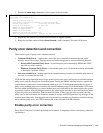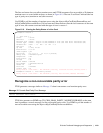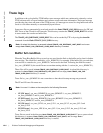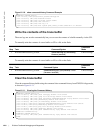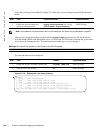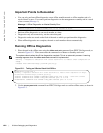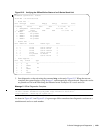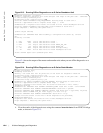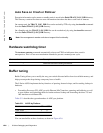
E-Series TeraScale Debugging and Diagnostics | 1219
Kernel core dump—The E-Series supports kernel core dumps for CP and for RP1/RP2 using a naming
convention of
f10{cp|rp{1|2}}.kcore.gz.
RP kernel core dumps are enabled by default. New files are written in flash until space is exhausted, in
which case the write is aborted.
CP kernel core dumps are disabled by default. Enable them using the command
logging coredump cp from
CONFIGURATION mode. If you use the keyword
cp with this command, the system creates a file, named
f10cp.kcore.gz, that preserves space on the internal flash so that there is always enough space for a core
dump. Undoing this command using the
no logging coredump cp removes this file. The CP kernel core
dumps are overwritten every time there is a new core dump. You should manually upload kernel core
dumps periodically if you want to save this information.
You may choose to write the core dump directly to an FTP server using the keyword
server. However, the
server option supports only RP coredumps; it does not support CP coredumps. By default the kernel core
dump is sent to the root directory of the internal flash CP and the CORE_DUMP_DIR directory for RP.
Application core dump—On the E-Series, the application core dump has the file name format
f10{cp|rp{1|2}}<yymmddhhmmss>.acore.gz, where <yymmddhhmmss> is a time stamp, and FTOS writes
it to the internal flash.
The FTOS High Availability module is aware of the core dump upload, and it does not reboot the crashed
RPM until the core dump has completed or is aborted.
Line card core dumps
Line card core dumps preserve critical status information for cards which experience a task crash.
Writing a line card core dump to memory on the RPM requires 5 to 30 minutes. During this time, the
physical interfaces remain in their current state, which is normally operationally up. This behavior assumes
that most FTOS agent tasks running on the line card CPU continue to operate correctly and that you want
to maximize uptime by having packets continue to flow while FTOS writes the core dump.
If you want to failover to a redundant system when a line card exception occurs, use the command
logging
coredump linecard port-shutdown
(Figure 663) to shut down ports during a core dump so that the backup
system can take over.
Note: The kernel core dump can be large and may take up to 5 to 30 minutes to upload. FTOS does not
overwrite application core dumps, so you should delete them as necessary to conserve space on the flash;
if the flash is out of memory, the core dump is aborted. On the S-Series, if the FTP server is not reachable,
the application core dump is aborted.
Message 21 Task Crash Detection
%E48TF:0 %TME-2-TASK SUSPENDED: LINECARD TASK SUSPENDED. SAVING FAILURE RECORD IN PROGRESS



